Welcome to Digital Audio Editing Fundamentals! This book takes you through the foundation of digital audio, as well as manual and algorithmic data sample editing. I start with the lowest-level concepts
—in this chapter it’s the sound wave—and build upon each of these concepts in subsequent chapters until you have a comprehensive understanding of digital audio editing concepts, terminology, audio file formats, work flows, waveform editing, effects processing, and data footprint optimization.
I show you what these concepts, techniques, and terms look like using the most popular digital audio editing software package—open source Audacity 2.1.1, which just so happens to be free for commercial use.
For this reason, the first part of the chapter covers exactly how to download and install Audacity 2.1.1—just in case you don’t currently own any digital audio editing software packages. After this, you learn about the foundational element of digital audio editing, which the industry professionals call a waveform or a sample. Once you put one together with other waveforms, your new media result comprises what’s called digital audio content.
This book is all about the way your audio waveform samples are edited and processed. Each chapter builds on knowledge from the preceding chapters, until you understand the digital audio sample editing work process.
Downloading and Installing Audacity
You need to have digital audio editing software of one type or another, whether it is Avid ProTools, Cakewalk SONAR, or Propellerhead Reason. If you do not own any of these, you can use the free-for-commercial-use Audacity
. Let’s install Audacity and free audio encoders.
AudacityTeam.org: Get Your Audacity 2.1 Software
To download Audacity 2.1.1, which is the current stable version, go to
www.audacityteam.org
and click the Download Audacity 2.1.1 link (see Figure 1-1), or alternately, click the Download tab, which is directly underneath the Audacity logo.

Figure 1-1.
Go to the audacityteam.org site and click Download
Download the audacity-win-2.1.1.exe installer file if you are using Windows (otherwise, the Linux or Mac version) and then double-click it to start your installation process. Audacity for Windows is a 32-bit version; if you want to run 64-bit Audacity, use Linux.
Once the installation starts, select the language that you want to use for your audio editing (I chose English), and then click the OK button (see Figure 1-2).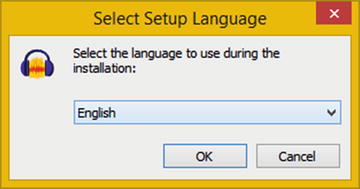

Figure 1-2.
Select the language
for the install
After you click the OK button, you see the Welcome to the Audacity Setup Wizard dialog. Click Next to continue.
Review the GNU license information (see the right screen in Figure 1-3) and then click the Next button.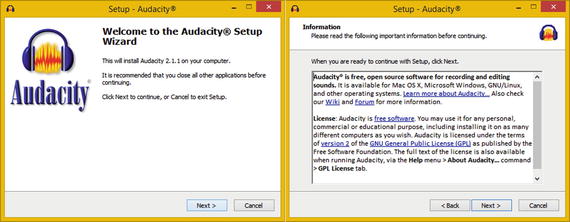

Figure 1-3.
Click Next to read GNU licensing information
I recommend that you use the destination location default specified by the installer—C:Program Files (x86)Audacity—since that is where the third-party products compatible with Audacity will look for the software on your computer system. Click Next. Select Create a desktop icon and Reset Preferences, and then click Next to continue (see Figure 1-4). Then select your icon and your preference options.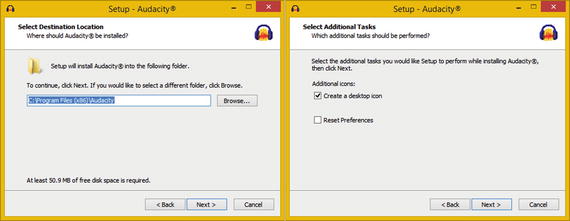

Figure 1-4.
Accept default installation options
, and click Next
Once you have specified your setup configurations, click the Install button (seen in the left screen in Figure 1-5). Audacity proceeds to install the software, displaying a green progress bar (shown in the right screen in Figure 1-5).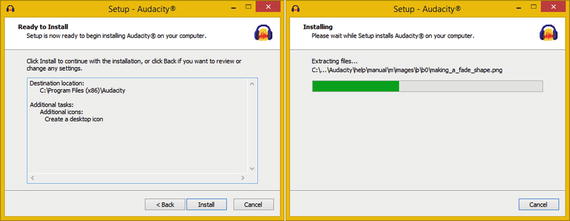

Figure 1-5.
Click the Install button to begin the installation
After the installation process is complete, you get another Information dialog (see the left screen in Figure 1-6). Click the Next button and select the Launch Audacity check box. To finish the installation and launch Audacity, click the
Finish button
.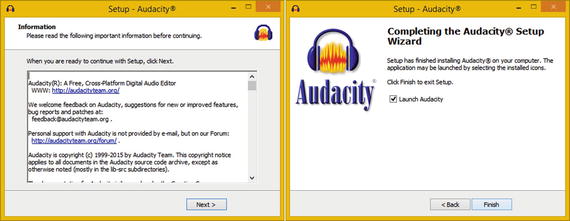

Figure 1-6.
After your install completes, click Next and Finish
Be sure to create a shortcut icon for your Quick Launch taskbar in your operating system (OS), so that you can launch Audacity with just a single mouse-click.
Audio File Formats : Installing FFMPEG and LAME
If you click the Download tab on the Audacity homepage (see Figure 1-7), you’ll see a Plug-Ins and Libraries link on the left, where you’ll find additional plug-ins and sound libraries
.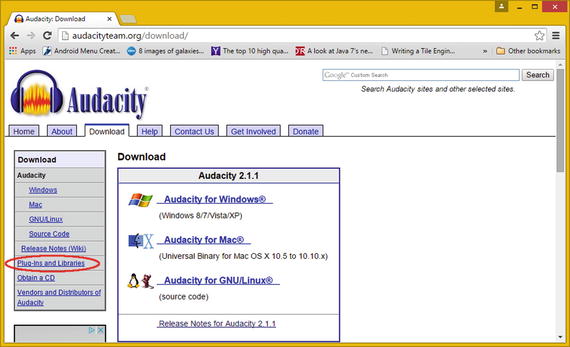

Figure 1-7.
Click the Download tab to find Plug-Ins and Libraries
You also need to get the LAME and FFMPEG libraries, which are located on the lame.buanzo.org web site (see Figure 1-8). Click the link for Windows or for Mac, depending on what OS you are using. Linux users have libraries for LAME and FFMPEG already installed, as part of the Linux OS.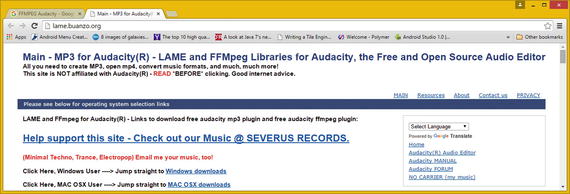

Figure 1-8.
Click the operating system link
for Windows or Mac
Since I am on Windows 8.1, I found the LAME 3.99.3 for Windows EXE file, downloaded it, and installed it onto my computer, where Audacity will find it each time it starts up.
I also downloaded and installed the FFMPEG 2.2.2 EXE file so that I will be able to import or export MPEG and other formats (see Figure 1-9).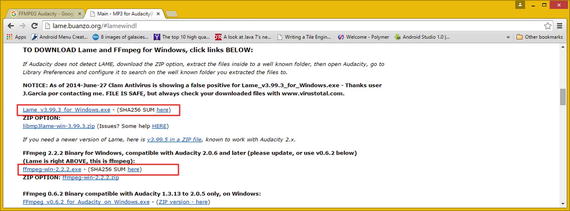

Figure 1-9.
Download LAME 3.99.3 and FFMPEG 2.2.2 libraries
Installing these libraries is easy and requires no option specifications or shortcut icons. When you launch the Audacity software after these libraries are installed, you are able to read and write all the audio file formats covered in this book; they are supported in Android, HTML5, iOS, Java, JavaFX, Blackberry, Linux, Mac OS, and Windows.
Now let’s take a look at the foundation
for all audio—a sound wave, which can be generated using both analog and digital audio technology. After all, this is Chapter 1, so you should get something under your belt besides installing an impressive open source digital audio editor and a special effects software application.
A Foundation for Audio: The Sound Wave
Digital audio editing, synthesis, MIDI sequencing, composition, sweetening, sound design, and special effects can all be quite complex, especially at the professional level. Even though this is a “fundamentals” title, I am going to try and cover a lot of concepts, history, techniques, terminology, formats, platforms, and work processes, so that you really get your money’s worth out of this digital audio editing fundamentals (and more) book.
Part of the complexity comes from
the need to “bridge” analog audio technology and digital audio technology together. This is necessary because modern-day devices use digital audio, but we still have analog audio in our lives—in our cars, home stereos, home theaters, movie theaters, at live concerts, sports stadiums, broadcast radio, live theater, clubs, and so forth. Therefore, I cover both analog audio and digital audio in this first chapter, as they both ultimately use sound waves to create the music, dialog, effects, and other audio that we experience.
Analog Audio: Sound Waves Formed Out of Air
Analog audio
is generated by using speaker cones of different sizes, which are manufactured using resilient membranes made out of one space-age material or another. Many of us have these speakers in our homes. I have 15-inch speakers right here on my desk. Larger 18- and 24-inch speakers are common in public venues, such as stadiums, theaters, and concert halls. These speakers generate sound waves by vibrating—or more accurately, pulsing—the sound waves into existence. Our ears receive these analog audio waves in exactly the opposite fashion, by catching or receiving those pulses of air, or vibrations, with different wavelengths, and then turning them back into “data” that our brain can process. This is how we “hear” the sound waves. Our brains then interpret the different audio sound wave frequencies as notes, tones, speech, sounds of nature, music, or sound effects.
A sound wave generates a different tone depending on the frequency of the sound wave, or the width (horizontal size) of the wave. Wide, long, or infrequent wave cycles produce a lower (bass) tone; whereas narrow, short, or frequent wavelengths produce a higher treble tone. Figure 1-10 visualizes this using a sine wave.
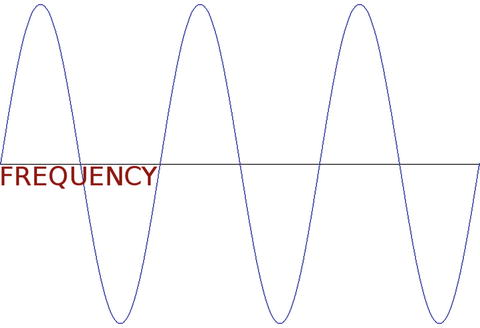

Figure 1-10.
Frequency is the width of one full wave cycle
It is interesting to note that different frequencies of light produce different colors; so there is a very close correlation between analog sound (audio) and analog light (color). Both are “bridged” from analog to digital, and the same principles therefore carry through to digital production techniques, work processes, and principles. I point out these similarities throughout the book, in case you are interested in digital imagery compositing. In fact, I also have a Digital Image Compositing Fundamentals (Apress, 2015) title, which goes into these areas.
The volume of the sound wave is predicated upon the amplitude of that sound wave, or the height (vertical size) of the wave. Thus, the frequency of sound waves equates to how closely together the waves are spaced along the x axis, if you look at this in two dimensions, and the amplitude equates to how tall the waves are as measured along the y axis. This is shown in Figure 1-11 using a basic sine audio wavef
orm.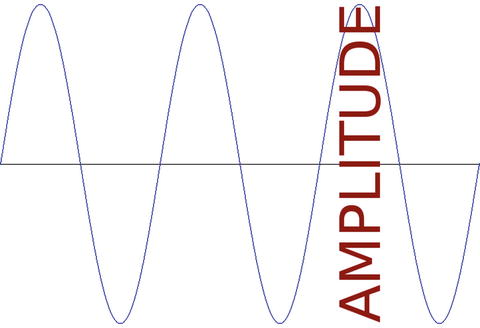

Figure 1-11.
Amplitude
is the height of the sound wave
A “baseline” sound wave type is called a
sine wave
. This type of sound wave is usually synthesized and it produces a clean, simple tone. You learned about these sine waves in your high school trigonometry class, when you learned about sine, cosine, and tangent mathematical functions.
Sound waves can be uniquely shaped, which allows them to mimic different sound effects. Those of you who are familiar with synthesizer keyboards are aware that there are many other shapes of sound waves that are used in sound design, including a
saw wave
, which looks like the edge of a saw—hence its name, or a
pulse wave
, which is shaped using right angles, resulting in immediate on-and-off sounds that translate into pulses.
Even
randomized waveforms
, such as noise, can be used in sound design to obtain an edgy sound result. As you will learn when we get into data footprint optimization, the more “chaos,” or noise, that is present in sound waves, the harder it is to compress in the compression algorithm (codec). This results in a significantly larger digital audio data footprint for that particular sound wave. Thus, cleaner sound waves compress better than dirtier (noisier) sound waves.
Digital Audio : Sound Waves Formed Out of Bytes
The way that analog audio is “bridged” over into the digital domain is by a process called “sampling,” which I cover in Chapter 3, as it is a very important topic for digital audio editing. This sound wave sampling process is one of the core tools of sound design and music synthesis, and it is named as such because you take “samples” of the analog sound wave to create a digital replica of that sound wave.
The audio wave sample has data sampled in a Y dimension, called the sample’s
resolution
, and the number of samples taken in the X dimension is called the
sampling frequency
. This data sample can later be used by the digital device (smartphone, PC, tablet, e-reader, smartwatch, iTV) audio playback hardware to re-create that analog waveform and then send it back out of the speaker, or out of your headphones jack and into your headphones.
I’ll cover how sampling is done and the various industry terms used, as well as the standard sample resolutions and standard sampling frequencies used in the industry.
These audio samples are used in MIDI synthesis keyboards, commonly called “samplers,” as well as in sound design software such as Cakewalk SONAR, Ableton Live, or Propellerhead Reason.
Summary
In this chapter, I made sure that you had a digital audio editing software package installed and ready to master. I also covered the foundational element of both analog and digital audio, the sound wave.
You learned about sound wave frequency, or width, and amplitude, or height, and the different types of sound waves that are used in MIDI synthesizers.
Next, you looked at the concept of sampling, or taking data samples of a sound wave to convert it from an analog waveform into digital audio data.
In the next chapter, you look at the history of digital audio and the concept of MIDI sequencing.
